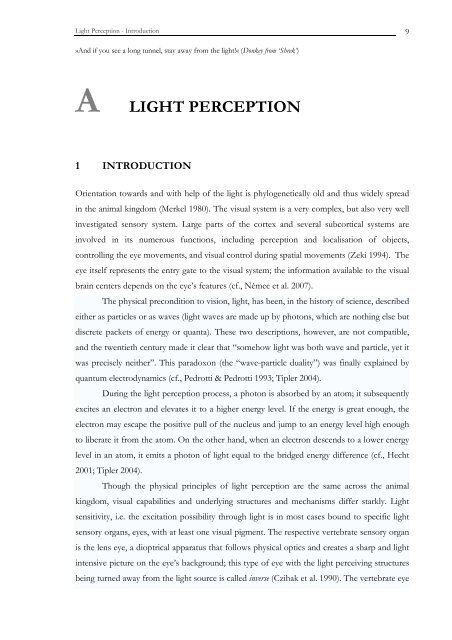Antigen Biotinylated Anti-Rabbit lgs Rabbit Primary Antiserum AB ...
Antigen Biotinylated Anti-Rabbit lgs Rabbit Primary Antiserum AB ...
Antigen Biotinylated Anti-Rabbit lgs Rabbit Primary Antiserum AB ...
You also want an ePaper? Increase the reach of your titles
YUMPU automatically turns print PDFs into web optimized ePapers that Google loves.
Light Perception - Introduction<br />
»And if you see a long tunnel, stay away from the light!« (Donkey from ‘Shrek’)<br />
A LIGHT PERCEPTION<br />
1 INTRODUCTION<br />
Orientation towards and with help of the light is phylogenetically old and thus widely spread<br />
in the animal kingdom (Merkel 1980). The visual system is a very complex, but also very well<br />
investigated sensory system. Large parts of the cortex and several subcortical systems are<br />
involved in its numerous functions, including perception and localisation of objects,<br />
controlling the eye movements, and visual control during spatial movements (Zeki 1994). The<br />
eye itself represents the entry gate to the visual system; the information available to the visual<br />
brain centers depends on the eye’s features (cf., Němec et al. 2007).<br />
The physical precondition to vision, light, has been, in the history of science, described<br />
either as particles or as waves (light waves are made up by photons, which are nothing else but<br />
discrete packets of energy or quanta). These two descriptions, however, are not compatible,<br />
and the twentieth century made it clear that “somehow light was both wave and particle, yet it<br />
was precisely neither”. This paradoxon (the “wave-particle duality”) was finally explained by<br />
quantum electrodynamics (cf., Pedrotti & Pedrotti 1993; Tipler 2004).<br />
During the light perception process, a photon is absorbed by an atom; it subsequently<br />
excites an electron and elevates it to a higher energy level. If the energy is great enough, the<br />
electron may escape the positive pull of the nucleus and jump to an energy level high enough<br />
to liberate it from the atom. On the other hand, when an electron descends to a lower energy<br />
level in an atom, it emits a photon of light equal to the bridged energy difference (cf., Hecht<br />
2001; Tipler 2004).<br />
Though the physical principles of light perception are the same across the animal<br />
kingdom, visual capabilities and underlying structures and mechanisms differ starkly. Light<br />
sensitivity, i.e. the excitation possibility through light is in most cases bound to specific light<br />
sensory organs, eyes, with at least one visual pigment. The respective vertebrate sensory organ<br />
is the lens eye, a dioptrical apparatus that follows physical optics and creates a sharp and light<br />
intensive picture on the eye’s background; this type of eye with the light perceiving structures<br />
being turned away from the light source is called inverse (Czihak et al. 1990). The vertebrate eye<br />
9

















